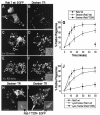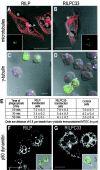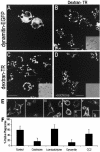Phagosomes fuse with late endosomes and/or lysosomes by extension of membrane protrusions along microtubules: role of Rab7 and RILP
- PMID: 12944476
- PMCID: PMC193691
- DOI: 10.1128/MCB.23.18.6494-6506.2003
Phagosomes fuse with late endosomes and/or lysosomes by extension of membrane protrusions along microtubules: role of Rab7 and RILP
Abstract
Nascent phagosomes must undergo a series of fusion and fission reactions to acquire the microbicidal properties required for the innate immune response. Here we demonstrate that this maturation process involves the GTPase Rab7. Rab7 recruitment to phagosomes was found to precede and to be essential for their fusion with late endosomes and/or lysosomes. Active Rab7 on the phagosomal membrane associates with the effector protein RILP (Rab7-interacting lysosomal protein), which in turn bridges phagosomes with dynein-dynactin, a microtubule-associated motor complex. The motors not only displace phagosomes in the centripetal direction but, strikingly, promote the extension of phagosomal tubules toward late endocytic compartments. Fusion of tubules with these organelles was documented by fluorescence and electron microscopy. Tubule extension and fusion with late endosomes and/or lysosomes were prevented by expression of a truncated form of RILP lacking the dynein-dynactin-recruiting domain. We conclude that full maturation of phagosomes requires the retrograde emission of tubular extensions, which are generated by activation of Rab7, recruitment of RILP, and consequent association of phagosomes with microtubule-associated motors.
Figures









Similar articles
-
Activation of endosomal dynein motors by stepwise assembly of Rab7-RILP-p150Glued, ORP1L, and the receptor betalll spectrin.J Cell Biol. 2007 Feb 12;176(4):459-71. doi: 10.1083/jcb.200606077. Epub 2007 Feb 5. J Cell Biol. 2007. PMID: 17283181 Free PMC article.
-
The Rab7 effector protein RILP controls lysosomal transport by inducing the recruitment of dynein-dynactin motors.Curr Biol. 2001 Oct 30;11(21):1680-5. doi: 10.1016/s0960-9822(01)00531-0. Curr Biol. 2001. PMID: 11696325
-
Modulation of Rab5 and Rab7 recruitment to phagosomes by phosphatidylinositol 3-kinase.Mol Cell Biol. 2003 Apr;23(7):2501-14. doi: 10.1128/MCB.23.7.2501-2514.2003. Mol Cell Biol. 2003. PMID: 12640132 Free PMC article.
-
Rab7: role of its protein interaction cascades in endo-lysosomal traffic.Cell Signal. 2011 Mar;23(3):516-21. doi: 10.1016/j.cellsig.2010.09.012. Epub 2010 Sep 21. Cell Signal. 2011. PMID: 20851765 Review.
-
Maturation of autophagosomes and endosomes: a key role for Rab7.Biochim Biophys Acta. 2013 Mar;1833(3):503-10. doi: 10.1016/j.bbamcr.2012.11.018. Epub 2012 Dec 5. Biochim Biophys Acta. 2013. PMID: 23220125 Review.
Cited by
-
Relationship between the expression of Rab family GTPases and neuropeptide hormones in the brain of Bombyx mori.Histochem Cell Biol. 2013 Feb;139(2):299-308. doi: 10.1007/s00418-012-1021-5. Epub 2012 Aug 25. Histochem Cell Biol. 2013. PMID: 22922733
-
Salmonella actively modulates TFEB in murine macrophages in a growth-phase and time-dependent manner.Microbiol Spectr. 2024 Jan 11;12(1):e0498122. doi: 10.1128/spectrum.04981-22. Epub 2023 Dec 5. Microbiol Spectr. 2024. PMID: 38051049 Free PMC article.
-
Endoplasmic reticulum-Phagosome contact sites from the cradle to the grave.Front Cell Dev Biol. 2022 Dec 22;10:1074443. doi: 10.3389/fcell.2022.1074443. eCollection 2022. Front Cell Dev Biol. 2022. PMID: 36619860 Free PMC article. Review.
-
Phagocytosis: A Fundamental Process in Immunity.Biomed Res Int. 2017;2017:9042851. doi: 10.1155/2017/9042851. Epub 2017 Jun 12. Biomed Res Int. 2017. PMID: 28691037 Free PMC article. Review.
-
Contrasting Lifestyles Within the Host Cell.Microbiol Spectr. 2016 Feb;4(1):10.1128/microbiolspec.VMBF-0014-2015. doi: 10.1128/microbiolspec.VMBF-0014-2015. Microbiol Spectr. 2016. PMID: 26999394 Free PMC article. Review.
References
-
- Allen, L. A., and A. Aderem. 1996. Mechanisms of phagocytosis. Curr. Opin. Immunol. 8:36-40. - PubMed
-
- Alvarez-Dominguez, C., A. M. Barbieri, W. Beron, A. Wandinger-Ness, and P. D. Stahl. 1996. Phagocytosed live Listeria monocytogenes influences Rab5-regulated in vitro phagosome-endosome fusion. J. Biol. Chem. 271:13834-13843. - PubMed
-
- Alvarez-Dominguez, C., and P. D. Stahl. 1999. Increased expression of Rab5a correlates directly with accelerated maturation of Listeria monocytogenes phagosomes. J. Biol. Chem. 274:11459-11462. - PubMed
-
- Blocker, A., G. Griffiths, J. C. Olivo, A. A. Hyman, and F. F. Severin. 1998. A role for microtubule dynamics in phagosome movement. J. Cell Sci. 111:303-312. - PubMed
Publication types
MeSH terms
Substances
Grants and funding
LinkOut - more resources
Full Text Sources
Molecular Biology Databases
